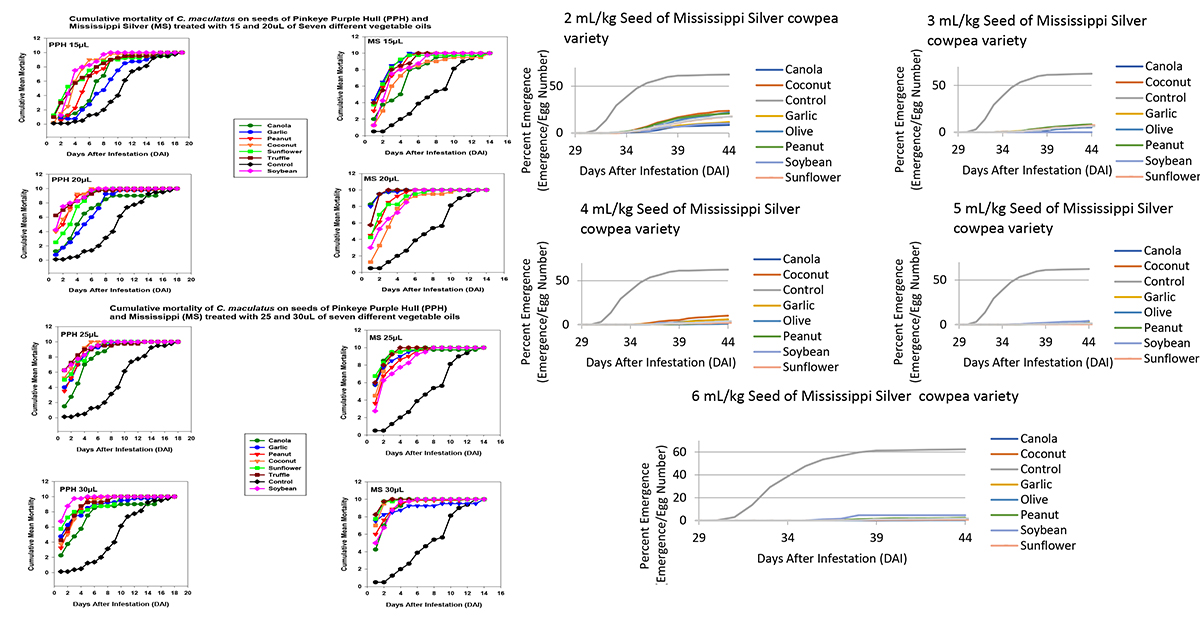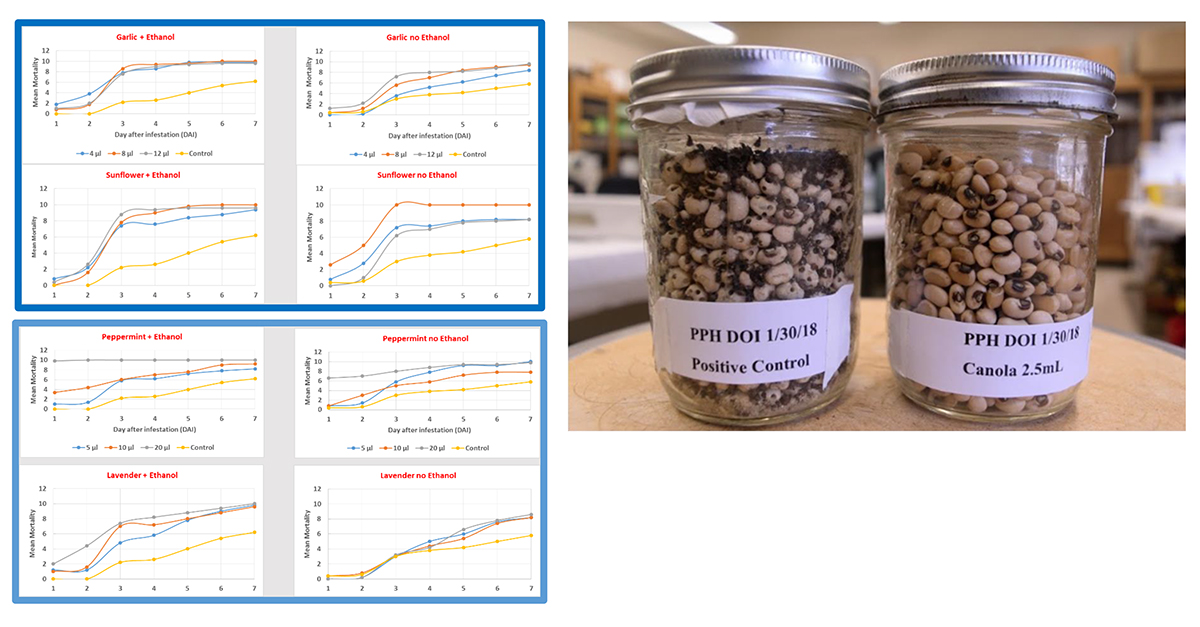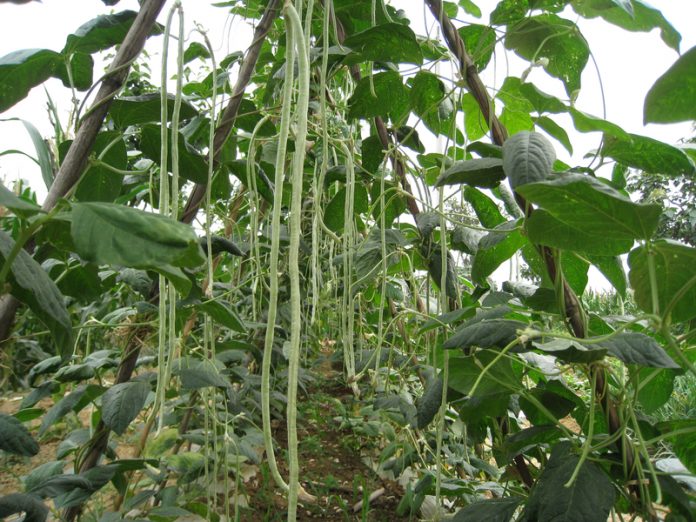Louis E. N. Jackai, PhD, Professor and IPM Specialist and Dr. Beatrice N. Dingha, Associate Research Professor at the Department of Natural Resources and Environmental Design share with us their thoughts on post-harvest protection for smallholder cowpea production using vegetable oil, “STOPCALLOSOBRUCHUS!”
Cowpea is one of the most diverse, versatile and economically important indigenous legume crops in the world. Cowpea is of vital importance to the livelihood of millions of people in the developing world, as well as in the southern U.S. where it is grown mainly by small urban and rural growers for food, income and as a summer cover crop. It enriches (feeds) the soil with nitrogen for use by the next crop, and in the Southeastern U.S. cowpea is commonly consumed as a green, frozen or canned bean, but more widely as a “Crowder” or “Blackeye” pea sold in many grocery stores across the nation.
In our recent publications (Jackai et al., 2017, 2018), we present cowpea in its historical perspective, nutritional and health value to humans and livestock, as well as its vulnerability to pests and diseases. Trap cropping was featured as a potential non-chemical approach for controlling the invasive Brown marmorated stink bug, Halyomorpha halys (Stal). Cowpea has great potential as an all-round crop for a wide range of environments. Its attributes as a versatile crop are greatly limited and diminished by a number of biotic stresses among which insect pests, weeds and diseases are clearly among the most challenging (see review by Kumar and Kalita, 2017).
This paper in the series focuses on post-harvest protection, which we consider the most critical mitigating factor in the alleviation of food security, especially in developing countries in Africa, Asia and South/Central America which depend heavily on legumes (especially cowpea) as a source of high protein for humans and livestock and as a source of family income. Post harvest losses of cowpea typically exceed 45% worldwide.
Post-harvest losses in cowpea
The title of this paper sounds a clarion call to a lingering pest problem that has placed the realisation of the full benefits of cowpea in a state of limbo for longer than anyone could have imagined. This is most surprising especially given all the years of research and hundreds of publications on the subject at both ends of the sophistication continuum, by highly respected scholars and those not so distinguished.
So we ask ourselves what has gone wrong after all the years of intense investigation? The truth is that if we discount the use of synthetic insecticides, nothing spectacular has been accomplished in the sense that the problem persists. Many estimates of the losses from storage are underestimates, especially in traditional spaces (Kumar and Kalita, 2017). Have we focused too much on the sophisticated and played down the seemingly mundane that is usually regarded as “indigenous” knowledge (IK) and, therefore, without enough scientific merit to be useful?
That notwithstanding, a recent grain and seed storage protection technology has been deployed in West Africa with promising results. It uses hermetic storage that employs triple layer bags, a technique referred to as the “Purdue Improved Crop Storage” or PICS (Baributsa et al., 2010; Baoua et al, 2015; Murdoch et al, 2012) has the effect of reducing oxygen levels in sealed bags from 21% to 18% after almost seven months of storage. The technology followed closely behind earlier research on solarisation from the same Purdue University laboratory (Ntoukam et al., 1997) that was a scientific spin-off from a common practice by cowpea farmers in Northern Cameroon, in West Africa. This is a good indication that IK can lead to important scientific developments. The PICS technique uses two high-density polyethylene liners (80 μm thick) woven into a polypropylene bag; however, these bags are not so secure as to be guaranteed from being pierced by sharp objects or rodents during transportation, or storage, in the supply chain. Should this happen, the entire PICS operation will be compromised. It is therefore important to build, or stack, other control measures around this concept; the work we report here using vegetable oils is an important step in this direction.
Plant oils provide lasting protection
The use of both edible vegetable and essential plant oils for the control of storage pests of legumes and grains is not a new concept, but despite many years of dedicated research on this topic, a consistent protocol for the use of oils has not been put forward. Many oils are known to be effective but the rates used and the results reported are as different as the number of reporting workers. Our understanding of how and why these oils (vegetable and essential oils) work is still somewhat vague, and only a few workers have attempted to delve into the intricacies of the underlying mechanisms.
In this report, we do not try to resolve all outstanding questions; rather we hope to advance the scientific thought on which oils work best and for what target, the concentrations required for efficacy, as well as the need to understand the science on how they work on C. maculatus. Knowing the structure of an effective oil is also important because it represents a biochemical signature or marker whose footprints can be searched for in the libraries of hundreds of plant oils worldwide to find the best oils for the purpose of protecting commodities in storage. It is our belief that our discussion of this subject will establish a trajectory for scaling the use of oils in the control of other insects on legumes and other grain crops.
The most important pest, of stored cowpea, from a global distribution perspective, is the so-called “cowpea weevil” which is not a weevil (does not have a snout) but a beetle in the family Bruchidae, Order Coleoptera (the beetles). In this paper, we sometimes refer to this insect, Callosobruchus maculatus (Fab.), by the abbreviated form, “Cmac”. The clarion call in the title to “STOPCALLOSOBRUCHUS” is patterned after a similar name coined by the group seeking to control the invasive brown marmorated stink bug, H. halys in the U.S. using the mantra “StopBMSB.org”.
Most cowpea farmers are low-to-medium smallholders who are generally also limited resource growers with low income. It is therefore important for scientists target these growers with technology that is well within their grasp, both from a financial, as well as a technological standpoint. The PICS technology is an excellent example of this approach, judging from reports on its adoption (Kumar and Kalita, 2017). Vegetable oils and other cultural (IK-driven) approaches, such as the use of wood ash, various condiments (e.g. hot peppers – Capsicum spp.) and natural products, such as neem (Azadirachta indica) leaf powders and various biorational insecticides) should be deployed as toolbox components built around the nexus of plant resistance. These in conjunction with hermetic storage will, in our opinion, comprise the most reliable platform for a framework in the sustainable management of this pest. The discussion that follows on use of vegetable oils should be seen as a component of this collective (tactics in the toolbox) that constitute a veritable attempt to provide growers and the entire cowpea value chain with a reliable and durable IPM strategy for storage beetle control.
Enhancing storage protection technology using plant oils
Both essential oils (Nenaah et al, 2015; Akami et al., 2017) and the common edible vegetable oils (Kumar and Kalita, 2007) have been reported to be effective in the control of Cmac. In studies conducted in our laboratory, we evaluated eight commonly available edible vegetable oils (including garlic, soybean, peanut, sunflower, coconut, truffle, corn and olive oil) in Greensboro, North Carolina, against Cmac on cowpea seeds for up to six month storage period in some experiments. The results were simply outstanding. We were interested in oils that would: a) cause high adult mortality to reduce egg-laying, and b) possess ovicidal activity or prevent/greatly reduce adult emergence (by increasing within-seed mortality).
While other parameters may also be important, we believe that these two are the most critical for reducing and eventually eliminating any recurrent infestation, even in the absence of hermetic storage conditions. This is relevant given the understanding that the infestation may actually begin from the field and become exacerbated in storage. Increasing oil concentration generally increased adult mortality (Figure 1). At the lowest rate (15μl/20 grams of seed), the less susceptible Mississippi Silver cowpea variety showed a distinct difference between treated seed and the untreated control, unlike in the highly susceptible Pinkeye Purple Hull cowpea variety.

Figure 2: Cumulative percent adult C. maculatus emergence on cowpea seed (var. Mississippi Silver) treated with different concentrations of seven edible vegetable oils and an untreated control over 44 days.
So, varieties behave differently according to their resistance status. With a higher number of adults dying, fewer eggs were laid and subsequently, even fewer adults were recruited into the next generation as indicated by the adult emergence levels (Figure 2). All the oils tested had a pronounced effect on adult emergence which increased with oil concentration.
In long-term studies, it is clear that oils alone could protect cowpea from Cmac damage. Obvious differences in the level of protection among the oils are observable among different oils.
One of the main bottlenecks to the adoption of vegetable oils in cowpea storage protection is the lack of consistency in their use. This is thought to be a result of poor coverage (coating of seeds or grain) when larger quantities have to be protected. There are two parts to a possible solution: a) having an appropriate carrier for the oils, and b) development of a simple but effective application process that would coat each grain/seed evenly. In studies carried out by Jackai and Dingha at NCA&T to improve coating, two essential oils (peppermint and lavender) and two edible vegetable oils (garlic and sunflower) were dissolved in ethanol to enhance coating. The results indicate that both the seed coating and biological effects of the oils were greatly improved by dilution in ethanol within 3 days (Figure 3). This process has obvious practical implications for seed/grain protection.
Regarding the coating process, the entomologists and biological engineers at N. Carolina A&T State University have developed a blueprint of a system that will uniformly coat each seed with a pre-determined amount of oil. Further testing is planned to determine various metrics on several biological variables in storage pest control, including persistence and shelf-life of various oils. Figures 1-4 show clearly that a range of oils can be very effective in long-term adult beetle suppression. We also know that some oils are persistent and remain effective for up to six months thus preventing, or greatly reducing, recruitment of new adults; eggs that were laid obviously did not survive (see Figure 4).

Figure 4: Seed damage and emerged C. maculatus adults on cowpea (var. Pinkeye Purple Hull) without oil treatment (left) after 6 months storage. No damage or emerged adults on cowpea treated with canola oil (right).
The Toolbox model for future grain storage protection for small growers
The PICS technique is by no means the first case of hermetic approach in storage protection; there have been many reports on this approach (Kumar and Kalila, 2017). The PICS technology has greatly improved the process and taken it to a different level of triple protection. But while this may be seen by some as a nexus for building a long-term, sustainable storage protection for small growers, others (including the current authors) would prefer to use cowpea resistance as the flagship around which to build the future scaffolding to protect legumes and other grains in storage.
Other controls (tools in the toolbox) can be built around, or anchored to, this core. Resistant varieties generally require less oil protection than do susceptible ones. This same phenomenon occurs with synthetic and biorational insecticides in the protection of field crops. Stacking resistance and oil with PICS will be a winner anywhere, any day. Relying on any single tool in the IPM toolbox is risky for the reasons outlined earlier, no matter how safe and secure the tactic looks.
The tools in this IPM toolbox should include the use of biorational insecticides such as diflubenzuron which is reported to be very effective on Cmac (Kemabonta et al., 2010), use of various plant oils (especially the more accessible and less expensive, safer and equally effective vegetable oils), in conjunction with hermitic storage on a plant resistance platform. This would be equivalent to stacking of genes except with a different activity span and a more diverse application scope as advocated by the tenets of IPM.
References Cited
Akami, M., H. Chakira, A.A. Andongma, K. Khaeso, O.A. Gbaye, N.Y. Nicolas, E.N. Nukenine and C.Y. Niu. 2017. Essential oil optimizes susceptibility of Callosobruchus maculatus and enhances the nutritional qualities of stored cowpea, Vigna unguiculata. R. Society Open Science 4: 170692.
Baribatsu, D., I.B. Baoua, O.N. Bakoye, L. Amadou and L.L. Murdock. 2017. PICS bags safely store shelled groundnuts in Niger. J. Stored Products Research. 72: 54-58.
Jackai, L.E.N., B.N. Dingha and M. Worku 2018). Cowpea – An ancient crop for modern challenges. Scientia (http://www.scientia.global/cowpea-an-ancient-crop-for-modern-challenges/), E-Book
Jackai, L.E.N. and B.N. Dingha. 2018. Transformative Research on Cowpea: Innovative trap crop development and deployment. Open Access Government 18: 340-341. https://edition.pagesuite professional.co.uk/html5/reader/production/default.aspx?pubname=&edid=558600cb-8de9-4616-9242-f8f3b41da315 (E-Book)
Kemabonta, K., J.A. Odebiyi and A.R. Olagbaju. 2010. An Assessment of Diflubenzuron as Protectant of Cowpea Grains against
Callosobruchus maculatus Fab. (Coleoptera: Bruchidae). Nigeria J. Science 44: 49-55.
Kumar, D, and P. Kalita. 2017. Reducing postharvest losses during storage of grain crops to strengthen food security in developing countries Foods 6(1), 8; https://doi.org/10.3390/foods6010008
Murdock, L.L., V.M. Margam, B.I. Baoua, S. Balfe and R.E. Shade. 2012. Death by desiccation: effects of hermetic storage on cowpea bruchids. J. Stored Product Research49: 166-170.
Nenaah, G.E., S.I.A. Ibrahim, B.A. Al-Assuity. 2015. Chemical composition, insecticidal activity and persistence of three Asteraceae essential oils and their nanoemultions against Callosobruchus maculatus. J. Stored Products Research 61: 9-16.
Ntoukam, G, L. Kitch , R.E. Shade and L.M. Murdock. 1997. A novel method for conserving cowpea germplasm and breeding stocks using solar disinfestation. Journal of Stored Products Research 33(2):175-179.
Dr. Louis E. N. Jackai
Professor and IPM Specialist
Department of Natural Resources and Environmental Design
Tel: +1 336 285 4837
http://www.ncat.edu/faculty/lejackai.html
Dr. Beatrice N. Dingha
Associate Research Professor
Department of Natural Resources and Environmental Design
Tel: 1 336 285 4864
https://www.ncat.edu/caes/facultystaff/profiles/bndingha.html
Please note: this is a commercial profile











